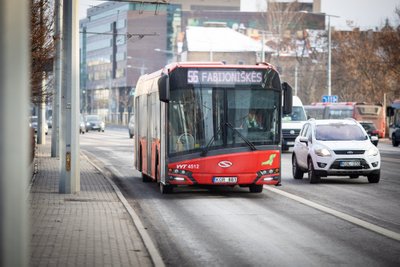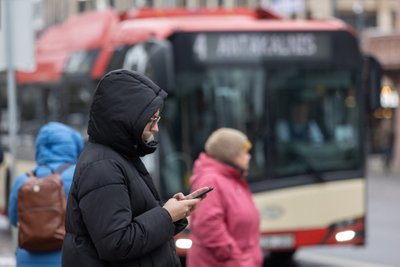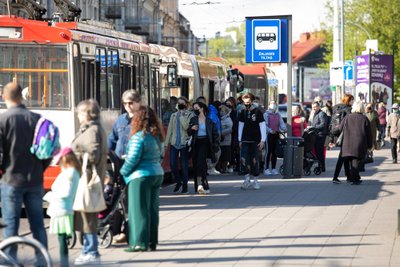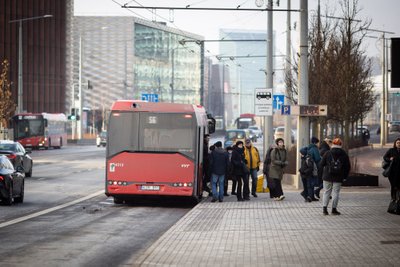Convenience is the priority, not sustainability
Ordinary vehicles that people use every day to reach their destinations are one of the major factors in terms of environmental pollution. Even though this is nothing new, and you do not have to be a genius to realize that your choices may be detrimental to your health and well-being, quite often young people are reluctant to change their ways.
“I’m used to driving a car, I do this every day. I drive to university, home, stores. When driving a car instead of, say, using public transport, it is easier to plan your day. Also, such issues like trolleybuses being late, too many people trying to get on, and so on simply do not exist,” said Kajus (name changed, actual name known to DELFI).
According to him, he has not thought about how to change this habit.
“Even though I know that cars pollute the environment we live in and the air that we breathe, I still prioritize convenience in this case,” he added.

Public transport as part of daily routine
Nevertheless, not all young people of Lithuania think like this. A good example is student Evelina (name changed, actual name known to DELFI).
“My habit of using public transport formed as soon as I moved to the capital. I used to live in a small town where the majority of destinations could be reached on foot, so the car that I was sharing with a family member was only needed for longer trips. I travel to the university using public transport and I do not feel any discomfort. It is actually convenient since I do not have to think about having to park the car, the parking fee, etc.” she explained.
Evelina added that although using public transport was part of her daily routine, often she did not even consider the fact that this habit allowed her contributing to saving the planet and helped save a lot of money.
“I go somewhere every day, so, yes, I guess I do save some money by using public transport. I buy monthly tickets because they are cheaper, plus I get a student’s discount. The price I pay for the ticket would not translate into a substantial amount of fuel for a car,” she noted.

According to Evelina, the majority of her peers also choose to use this sustainable and affordable to students means of transportation.
“Sure, there are those who prefer going everywhere by car, but in terms of travelling within the city limits, the majority of my friends choose public transport even though they have a driver’s license. I think there are many reasons why, but for many, public transport has become part of daily routine,” Evelina continued.
Some things could be improved
Ema (name changed, actual name known to DELFI), too, actively uses public transport in Vilnius. She noted that it was her main means of transportation in the capital.
“Since I do not possess a driver’s license and car, I have only two options left: public transport and taxi. Taxi services are not cheap, so I use it only when buses or trolleybuses are late or when I am in a hurry. Otherwise, I use public transport,” she elaborated.
Just like Evelina, Ema is also satisfied with the price.
“It is really great that students can purchase a monthly ticket for as little as EUR 5.80. This amount is basically pocket change and one of the advantages of public transport. And due to special lanes reserved for public transport you can avoid traffic jams and reach certain destinations faster than by car,” she pointed out.
On the other hand, the student has noticed certain nuances of public transport that make movement in the city unpleasant.
“The disadvantages are longer trips, disregard of timetables, the trolleybuses often are overcrowded – even not during the rush hour, it is difficult to get on and plan your journey since you may need to wait for a while for another one,” she complained.

Ema also criticized the quality of public transport vehicles.
“I would single out the old trolleybuses that can make a trip really challenging in winter: it is actually much colder inside than on the outside, very humid (it’s bad for you), the windows are constantly dewing, all kinds of breakdowns happen during the trip, and uncomfortable and rough experience,” Ema continued.
The challenges are not limited to winter, though.
“The ventilation is minimal, if there are more people, it gets really hot inside,” she stated.
Although she is using public transport every day and is not planning to change this habit in the near future, Ema would definitely implement certain changes immediately.
“First of all, I would replace the old Vilnius trolleybuses with new ones since it is not just a big disadvantage to the citizens, but also a shame to the city. Shame and mismanagement. Also, I would revise the timetables and add more buses to routes that are known to have large amounts of passengers,” the student suggested.
DELFI has also contacted the company Vilnius Public Transport and asked to comment on the opinions of citizens
“Already this year, we are starting the renewal of VPT fleet. There is a contract in place regarding the acquisition of 91 new trolleybuses. The very first new ones will reach Vilnius in summer, and now we are focused on the maintenance and repair of the current fleet to ensure safe and comfortable travel,” the reply said.

An attractive alternative
According to the young ladies, one of the advantages of public transport is attractive ticket prices. What is more, discounts apply not only to students, but also to pensioners, schoolchildren, the disabled, and those who have suffered during the resistance.
It is worth mentioning that the regular price of the monthly ticket is EUR 29 and the yearly one may cost as much as EUR 310, but the discounts allow saving huge amounts of money per the official website, judu.lt
Students are also very happy with the discounts. Based on the information on judu.lt another great thing is convenience. You can use your phone for pretty much everything related to public transport in Vilnius: buy tickets, check routes and timetables, and even track buses and trolleybuses in real time. Just download one of the available apps and plan your trip with ease.
Everyone can live more sustainably, you just need enough determination, aspiration, and understanding that everything that we do today will come around in the future – one way or another. Everyday habits can be changed. Even more so that there are so many alternatives in the modern world.

